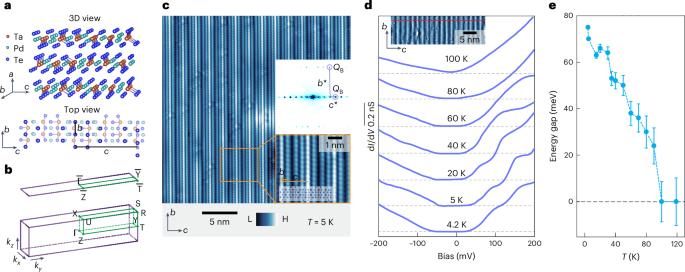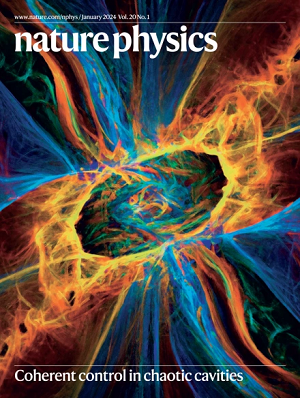Topological excitonic insulator with tunable momentum order
IF 18.4
1区 物理与天体物理
Q1 PHYSICS, MULTIDISCIPLINARY
引用次数: 0
Abstract
Correlated topological materials often maintain a delicate balance among physical symmetries. Many topological orders are symmetry protected, whereas most correlated phenomena arise from spontaneous symmetry breaking. Cases where symmetry breaking induces a non-trivial topological phase are rare. Here we demonstrate the presence of two such phases in Ta2Pd3Te5, where Coulomb interactions form excitons that condense below 100 K, one with zero and the other with finite momentum. We observed a full spectral bulk gap, which stems from exciton condensation. This topological excitonic insulator state spontaneously breaks mirror symmetries but involves a weak structural coupling. Scanning tunnelling microscopy shows gapless boundary modes in the bulk insulating phase. Their magnetic field response, together with theoretical modelling, indicates a topological origin. These observations establish Ta2Pd3Te5 as a topological excitonic insulator in a three-dimensional crystal. Thus, our results manifest a unique sequence of topological exciton condensations in a bulk crystal, offering exciting opportunities to study critical behaviour and excitations. Experimental systems in which non-trivial topology is driven by spontaneous symmetry breaking are rare. Now, topological gaps resulting from two excitonic condensates have been demonstrated in a three-dimensional material.


具有可调动量阶的拓扑激子绝缘子
相关拓扑材料通常在物理对称性之间保持微妙的平衡。许多拓扑序是对称保护的,而大多数相关现象是自发对称破缺引起的。对称破缺引起非平凡拓扑相位的情况很少见。在这里,我们证明了Ta2Pd3Te5中存在两个这样的相,其中库仑相互作用形成了在100k以下凝聚的激子,一个具有零动量,另一个具有有限动量。我们观察到一个全光谱体隙,这是由激子凝聚引起的。这种拓扑激子绝缘体状态自发地打破了镜像对称性,但涉及弱结构耦合。扫描隧道显微镜显示在体绝缘阶段无间隙边界模式。它们的磁场响应,连同理论模型,表明了拓扑起源。这些观察证实了Ta2Pd3Te5在三维晶体中是一种拓扑激子绝缘体。因此,我们的结果显示了块体晶体中独特的拓扑激子凝聚序列,为研究临界行为和激发提供了令人兴奋的机会。
本文章由计算机程序翻译,如有差异,请以英文原文为准。
求助全文
约1分钟内获得全文
求助全文
来源期刊

Nature Physics
物理-物理:综合
CiteScore
30.40
自引率
2.00%
发文量
349
审稿时长
4-8 weeks
期刊介绍:
Nature Physics is dedicated to publishing top-tier original research in physics with a fair and rigorous review process. It provides high visibility and access to a broad readership, maintaining high standards in copy editing and production, ensuring rapid publication, and maintaining independence from academic societies and other vested interests.
The journal presents two main research paper formats: Letters and Articles. Alongside primary research, Nature Physics serves as a central source for valuable information within the physics community through Review Articles, News & Views, Research Highlights covering crucial developments across the physics literature, Commentaries, Book Reviews, and Correspondence.
 求助内容:
求助内容: 应助结果提醒方式:
应助结果提醒方式:


